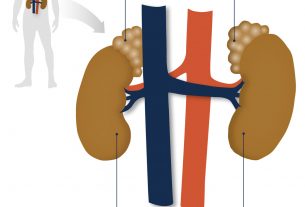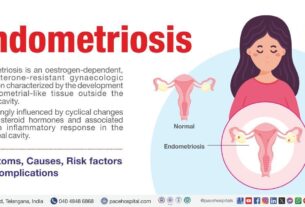Imagine a world where the miraculous journey of pregnancy takes a heart-stopping turn.
Within the ethereal realm of the womb, a haunting phenomenon lurks: the foetus papyraceus.
This enigmatic condition, shrouded in mystery and danger, unveils itself through the secrets whispered by sonographic examinations.
Brace yourself for a compelling exploration into a realm where life’s fragile embrace teeters on the brink.
foetus papyraceus
Foetus papyraceus is a rare condition in which one or more fetuses in the womb become compressed and ultimately resorbed, resulting in a paper-thin appearance.
It has been found to have an increased incidence with assisted reproductive techniques (ART) and is associated with a high morbidity and mortality rate for both the mother and the fetus.
The incidence of foetus papyraceus in pregnancies is 1 in 12,000, with a higher occurrence in twin pregnancies at 1 in 190.
This condition can occur in both monozygotic and dizygotic twins and is often associated with ovulation induction or in vitro fertilization.
Complications such as pre-eclampsia, disseminated intravascular coagulation, and thrombotic thrombocytopenic purpura can arise in the mother, while premature birth, low birth weight, and hypoxic ischemic encephalopathy are potential intrauterine complications.
Diagnosis typically occurs through sonographic examinations, and the effect on the surviving fetus and mother must be closely monitored.
In a case presentation of a 43-year-old primigravida who conceived through ART, three foetus papyraceus were identified, prompting an emergency caesarean section.
Two live births were achieved, highlighting the importance of prompt detection and intervention in managing this condition.
Key Points:
- Foetus papyraceus is a rare condition in which one or more fetuses become compressed and resorbed, resulting in a paper-thin appearance.
- The condition is more common in pregnancies resulting from assisted reproductive techniques (ART) and has a high morbidity and mortality rate for both the mother and the fetus.
- The incidence of foetus papyraceus in pregnancies is 1 in 12,000, with a higher occurrence in twin pregnancies at 1 in 190.
- This condition can occur in both monozygotic and dizygotic twins and is often associated with ovulation induction or in vitro fertilization.
- Complications in the mother can include pre-eclampsia, disseminated intravascular coagulation, and thrombotic thrombocytopenic purpura, while potential intrauterine complications include premature birth, low birth weight, and hypoxic ischemic encephalopathy.
- Diagnosis is typically done through sonographic examinations, and close monitoring of the surviving fetus and mother is necessary.
foetus papyraceus – Watch Video
https://www.youtube.com/watch?v=zK_s4LjlIZM
💡
Pro Tips:
1. Foetus papyraceus refers to an extremely rare medical phenomenon where the death of one twin in the womb results in the compression and preservation of its body, ultimately resembling a flattened piece of parchment or papyrus.
2. The term “Foetus papyraceus” is derived from Latin, where “foetus” means “unborn child” and “papyraceus” denotes something resembling paper due to its flat and dry appearance.
3. It is estimated that only one in every 12,000 pregnancies experiences foetus papyraceus, making it an extremely rare occurrence.
4. Foetus papyraceus can result from complications such as twin-to-twin transfusion syndrome, where one twin receives an insufficient amount of blood supply, leading to its demise. The surviving twin then compresses and absorbs the deceased twin.
5. In some cases, the presence of a foetus papyraceus can go unnoticed during the pregnancy, only to be discovered during the birth of the surviving twin.
Foetus Papyraceus – A Rare Condition
Foetus Papyraceus is a rare and fascinating medical condition that occurs during pregnancy. It is characterized by the compression of one fetus, resulting in its resorption or becoming paper-thin. This condition is often associated with complications for both the mother and the affected fetus. While uncommon, it has been found to have an increased incidence in pregnancies conceived through Assisted Reproductive Techniques (ART).
Compressed In-Utero: Understanding The Condition
Foetus Papyraceus is a fascinating phenomenon occurring within the uterus. This condition involves extreme compression of the developing fetus, resulting in its deformation and eventual resorption. Several factors can contribute to this compression, including the presence of another fetus or abnormal growth and development. While the precise mechanisms of Foetus Papyraceus are still not fully comprehended, inadequate blood flow and space restriction within the uterus are believed to play a role.
Resorption Or Paper Thin: Characteristics Of Foetus Papyraceus
When a fetus develops Foetus Papyraceus, it takes on unique characteristics that differentiate it from a typical developing fetus. The affected fetus becomes exceptionally thin, resembling a piece of paper. This is due to the compression it experiences in-utero. In some cases, the fetus may undergo partial or complete resorption, leaving behind only remnants. This rare occurrence highlights the astonishing potential of the human body to adapt and respond to unfavorable conditions.
Increased Incidence With Assisted Reproductive Techniques (Art)
Foetus Papyraceus is more commonly found in pregnancies that are conceived through Assisted Reproductive Techniques (ART), which involve procedures like ovulation induction and in vitro fertilization. The exact reasons behind this association are not fully understood, but it is believed that the manipulation of eggs and embryos during these procedures might play a role in the increased incidence of Foetus Papyraceus. This emphasizes the need for thorough monitoring and careful consideration when undergoing ART procedures.
High Morbidity And Mortality For Mother And Fetus
The presence of Foetus Papyraceus poses significant risks and challenges for both the mother and the affected fetus. The condition is associated with high morbidity and mortality for both parties involved. Complications such as pre-eclampsia, disseminated intravascular coagulation, and thrombotic thrombocytopenic purpura have been linked to Foetus Papyraceus.
Additionally, there are intrauterine impacts, including:
- Premature birth
- Low birth weight
- Hypoxic ischemic encephalopathy
These impacts can have long-lasting effects on the surviving fetus.
Please note that Foetus Papyraceus refers to the condition where one twin dies in the uterus and gets compressed by the surviving fetus, resulting in a flattened and parchment-like appearance of the deceased twin.
Incidence: 1 In 12,000 Pregnancies
Foetus Papyraceus is an exceptionally rare condition, with an estimated incidence of 1 in 12,000 pregnancies. This rarity adds to the intrigue and mystery surrounding this phenomenon. The infrequent occurrence of Foetus Papyraceus emphasizes the need for further research and understanding of this condition to improve management and outcomes for both mothers and affected fetuses.
Incidence In Twin Pregnancies: 1 In 190
In twin pregnancies, the incidence of Foetus Papyraceus is even more unusual, occurring in approximately 1 in 190 twin pregnancies. This condition adds an additional layer of complexity to the pregnancy, alongside the unique challenges that twins already present.
Key points:
- Foetus Papyraceus is rare in twin pregnancies, with an incidence of approximately 1 in 190.
- Twin pregnancies already have their own set of challenges.
- Foetus Papyraceus adds complexity and requires careful monitoring.
- Prompt medical intervention is crucial in managing these cases effectively.
“Careful monitoring and prompt medical intervention are crucial in managing these cases effectively.”
Occurrence In Monozygotic Or Dizygotic Twins
Foetus Papyraceus can occur in both monozygotic (identical) and dizygotic (fraternal) twins. The occurrence of this condition in monozygotic twins is particularly intriguing, considering their genetic similarity. It suggests that there are additional factors at play, such as uneven distribution of blood supply or space restrictions within the uterus. The occurrence in dizygotic twins further emphasizes the role of external factors, such as ART procedures, in influencing the development of Foetus Papyraceus.
- Foetus Papyraceus can occur in monozygotic and dizygotic twins.
- Factors such as uneven distribution of blood supply or space restrictions within the uterus may contribute to its occurrence in monozygotic twins.
- External influences, like ART procedures, can also play a role in the development of Foetus Papyraceus.
“The occurrence of this condition in monozygotic twins is particularly intriguing, considering their genetic similarity.”
Association With Ovulation Induction And In Vitro Fertilization
Foetus Papyraceus is closely linked to ovulation induction and in vitro fertilization (IVF), two widely used procedures in assisted reproductive technology (ART). The manipulation of eggs and embryos during these procedures can potentially raise the risk of Foetus Papyraceus development. This association underscores the importance of thorough evaluation and monitoring when employing ART techniques to achieve conception, as the potential risks go beyond the mere success of conception.
Associated Complications And Intrauterine Impact
Foetus Papyraceus is a rare condition that can have significant consequences for both the mother and the surviving fetus. Maternal complications include pre-eclampsia, disseminated intravascular coagulation, and thrombotic thrombocytopenic purpura, which can be life-threatening. Intrauterine complications encompass premature birth, low birth weight, and hypoxic ischemic encephalopathy, all of which can have long-lasting effects on the surviving fetus’s health and development. Thorough monitoring and timely medical interventions are essential in reducing the impact of these complications.
In conclusion, Foetus Papyraceus is an extraordinary phenomenon that presents unique challenges to both mothers and affected fetuses. Its rarity and association with ART procedures further contribute to its mysterious nature. Understanding the intricacies of this condition through comprehensive research will be crucial in improving management strategies and outcomes for those affected by Foetus Papyraceus.
💡
You may need to know these questions about foetus papyraceus
What is a Foetus papyraceus?
A Foetus papyraceus is a phenomenon that occurs when one twin in the womb dies early in pregnancy, and the remaining twin retains the deceased twin’s body for at least 10 weeks. Due to this prolonged retention, the small fetus undergoes mechanical compression and loses fluid, resulting in its appearance resembling parchment paper. It is a rare occurrence that highlights the complex and sometimes macabre aspects of fetal development in multiple pregnancies. Although distressing, this phenomenon provides unique insights into the intricacies of the womb’s environment and the body’s ability to adapt and respond to such situations.
What is the difference between fetus compressus and fetus papyraceus?
Fetus compressus and fetus papyraceus differ in their presentation and incorporation within the membranes or placenta of the live born twin. Fetus compressus is characterized by the flattening of the just-born twin, caused by pressure effects. However, it is not integrated into the membranes or placenta of the live-born twin due to insufficient time. On the other hand, fetus papyraceus refers to the situation where one twin dies and becomes flattened within the membranes or placenta of the surviving twin.
What is vanishing twin syndrome and fetus papyraceus?
Vanishing twin syndrome refers to a condition where a multiple pregnancy starts with the development of two or more embryos, but eventually one or more of the embryos are absorbed by the body, resulting in a reduced number of fetuses. This can occur at any stage of the pregnancy and may present with various manifestations such as the formation of a fetus papyraceus, which is essentially a “mummified” or compressed fetus. Alternatively, subtle abnormalities may develop on the placenta, such as cysts, subchorionic fibrin, or amorphous material. These occurrences reflect the complex and dynamic nature of multiple pregnancies and their potential complications.
What is another name for the fetus papyraceus?
Another name for the fetus papyraceus is “fetal compressus.” This condition is also known as vanishing twin syndrome, wherein one of the fetuses is compressed and mummified, resembling parchment, and remains attached to the placenta. This uncommon occurrence has various terms to describe it, including fetal papyraceus and fetal compressus.
Reference source
https://www.ncbi.nlm.nih.gov/pmc/articles/PMC6431712/
https://www.ncbi.nlm.nih.gov/pmc/articles/PMC6515779/
https://emedicine.medscape.com/article/271818-overview
https://www.ijogr.org/html-article/11508



